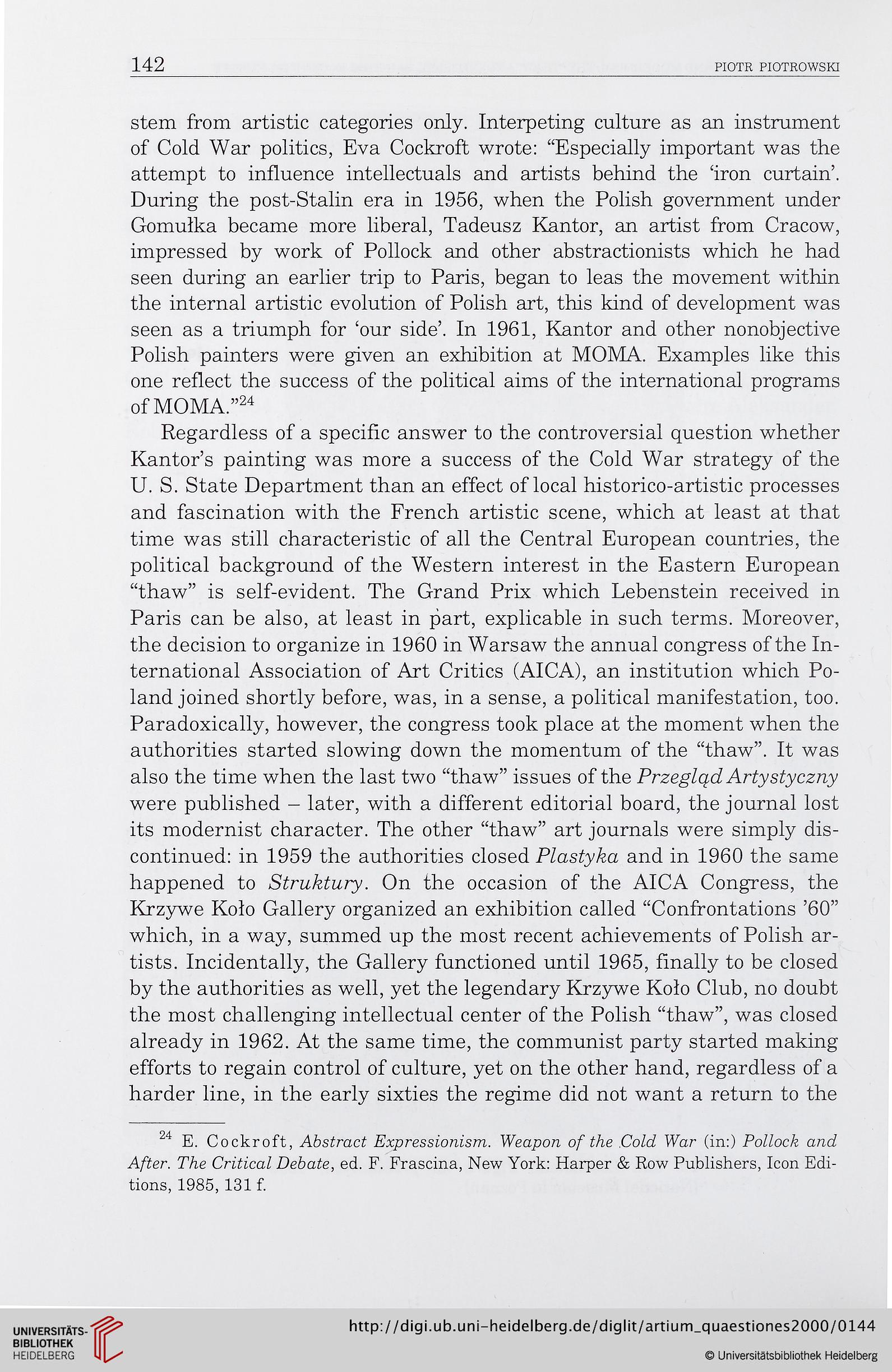142
PIOTR PIOTROWSKI
stem from artistic categories only. Interpeting culture as an instrument
of Cold War politics, Eva Cockroft wrote: “Especially important was the
attempt to influence intellectuals and artists behind the ‘iron curtain’.
During the post-Stalin era in 1956, when the Polish government under
Gomulka became more liberal, Tadeusz Kantor, an artist from Cracow,
impressed by work of Pollock and other abstractionists which he had
seen during an earlier trip to Paris, began to leas the movement within
the internai artistic évolution of Polish art, this kind of development was
seen as a triumph for ‘our side’. In 1961, Kantor and other nonobjective
Polish painters were given an exhibition at MOMA. Examples like this
one reflect the success of the political aims of the international programs
of MOMA.”24 * *
Regardless of a spécifie answer to the controversial question whether
Kantor’s painting was more a success of the Cold War strategy of the
U. S. State Department than an effect of local historico-artistic processes
and fascination with the French artistic scene, which at least at that
time was still characteristic of ail the Central European countries, the
political background of the Western interest in the Eastern European
“thaw” is self-evident. The Grand Prix which Lebenstein received in
Paris can be also, at least in part, explicable in such terms. Moreover,
the decision to organize in 1960 in Warsaw the annual congress of the In-
ternational Association of Art Critics (AICA), an institution which Po-
land joined shortly before, was, in a sense, a political manifestation, too.
Paradoxically, however, the congress took place at the moment when the
authorities started slowing down the momentum of the “thaw”. It was
also the time when the last two “thaw” issues of the Przeglqd Artystyczny
were published - later, with a different éditorial board, the journal lost
its modernist character. The other “thaw” art journals were simply dis-
continued: in 1959 the authorities closed Plastyka and in 1960 the same
happened to Struktury. On the occasion of the AICA Congress, the
Krzywe Koîo Gallery organized an exhibition called “Confrontations ’60”
which, in a way, summed up the most recent achievements of Polish ar-
tists. Incidentally, the Gallery functioned until 1965, fïnally to be closed
by the authorities as well, yet the legendary Krzywe Kolo Club, no doubt
the most challenging intellectual center of the Polish “thaw”, was closed
already in 1962. At the same time, the communist party started making
efforts to regain control of culture, yet on the other hand, regardless of a
harder line, in the early sixties the régime did not want a return to the
24 E. Cockroft, Abstract Expressiotiism. Weapon of the Cold War (in:) Pollock and
After. The Critical Debate, ed. F. Frascina, New York: Harper & Row Publishers, Icon Edi-
tions, 1985, 131 f.
PIOTR PIOTROWSKI
stem from artistic categories only. Interpeting culture as an instrument
of Cold War politics, Eva Cockroft wrote: “Especially important was the
attempt to influence intellectuals and artists behind the ‘iron curtain’.
During the post-Stalin era in 1956, when the Polish government under
Gomulka became more liberal, Tadeusz Kantor, an artist from Cracow,
impressed by work of Pollock and other abstractionists which he had
seen during an earlier trip to Paris, began to leas the movement within
the internai artistic évolution of Polish art, this kind of development was
seen as a triumph for ‘our side’. In 1961, Kantor and other nonobjective
Polish painters were given an exhibition at MOMA. Examples like this
one reflect the success of the political aims of the international programs
of MOMA.”24 * *
Regardless of a spécifie answer to the controversial question whether
Kantor’s painting was more a success of the Cold War strategy of the
U. S. State Department than an effect of local historico-artistic processes
and fascination with the French artistic scene, which at least at that
time was still characteristic of ail the Central European countries, the
political background of the Western interest in the Eastern European
“thaw” is self-evident. The Grand Prix which Lebenstein received in
Paris can be also, at least in part, explicable in such terms. Moreover,
the decision to organize in 1960 in Warsaw the annual congress of the In-
ternational Association of Art Critics (AICA), an institution which Po-
land joined shortly before, was, in a sense, a political manifestation, too.
Paradoxically, however, the congress took place at the moment when the
authorities started slowing down the momentum of the “thaw”. It was
also the time when the last two “thaw” issues of the Przeglqd Artystyczny
were published - later, with a different éditorial board, the journal lost
its modernist character. The other “thaw” art journals were simply dis-
continued: in 1959 the authorities closed Plastyka and in 1960 the same
happened to Struktury. On the occasion of the AICA Congress, the
Krzywe Koîo Gallery organized an exhibition called “Confrontations ’60”
which, in a way, summed up the most recent achievements of Polish ar-
tists. Incidentally, the Gallery functioned until 1965, fïnally to be closed
by the authorities as well, yet the legendary Krzywe Kolo Club, no doubt
the most challenging intellectual center of the Polish “thaw”, was closed
already in 1962. At the same time, the communist party started making
efforts to regain control of culture, yet on the other hand, regardless of a
harder line, in the early sixties the régime did not want a return to the
24 E. Cockroft, Abstract Expressiotiism. Weapon of the Cold War (in:) Pollock and
After. The Critical Debate, ed. F. Frascina, New York: Harper & Row Publishers, Icon Edi-
tions, 1985, 131 f.





